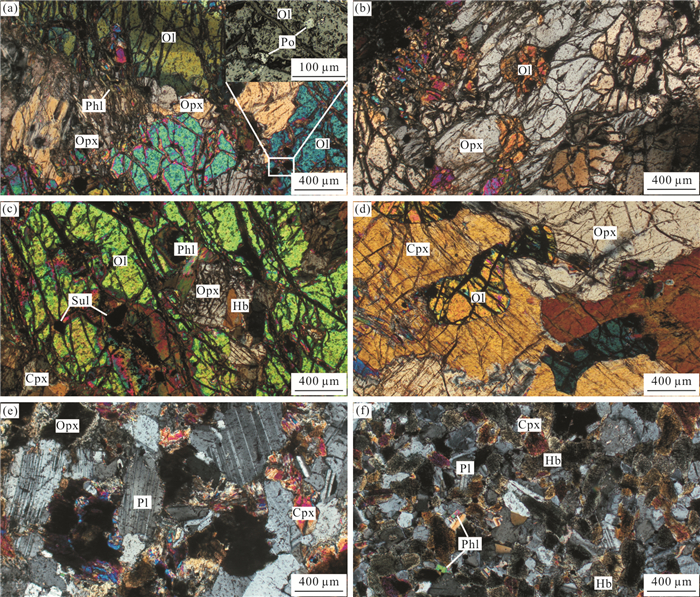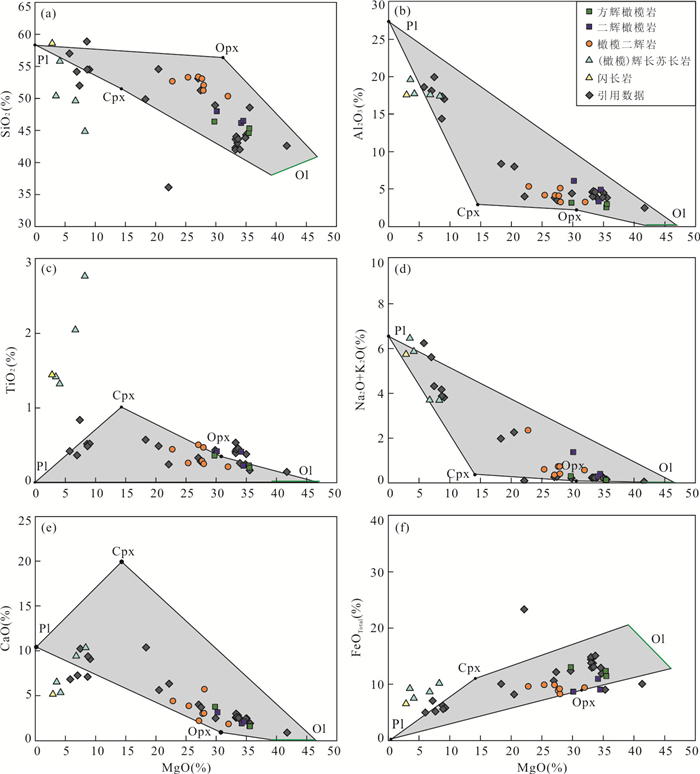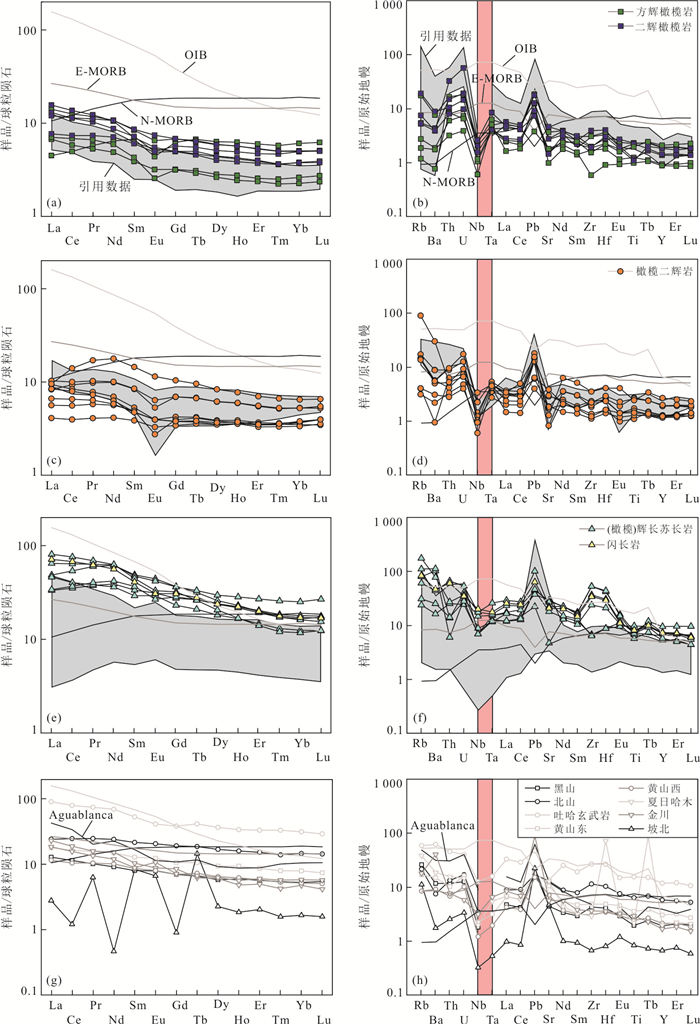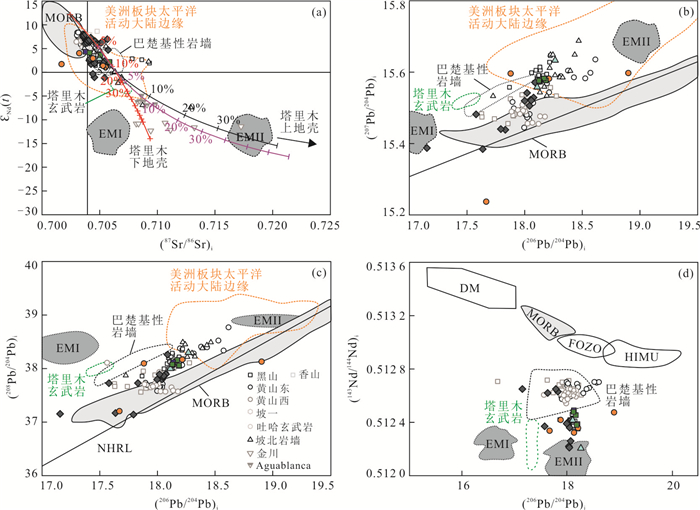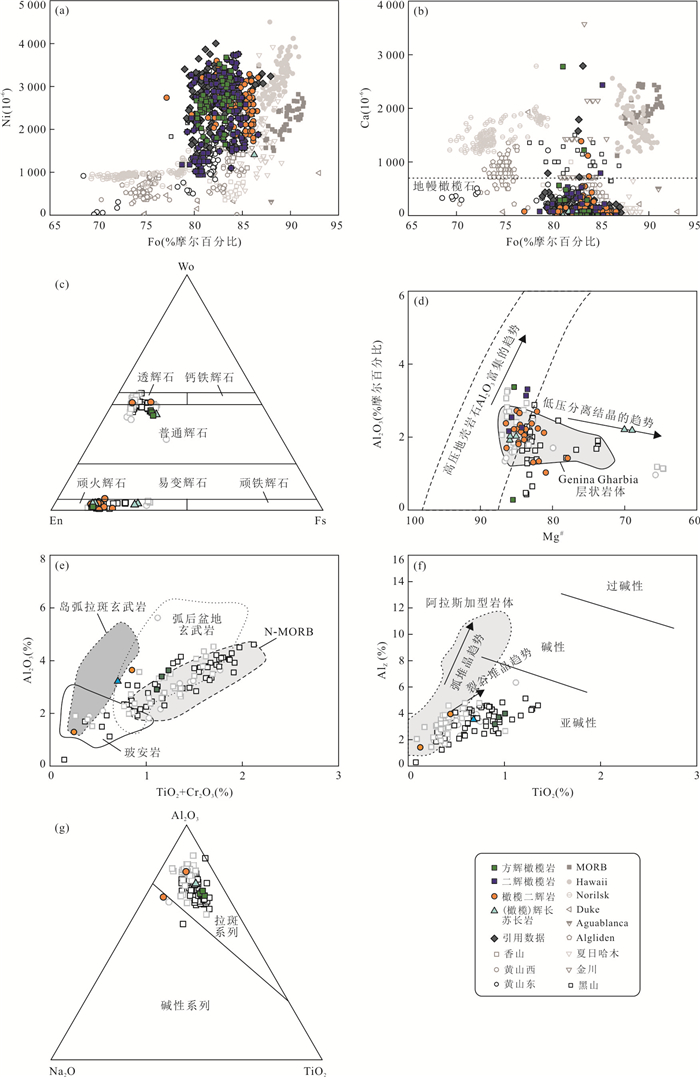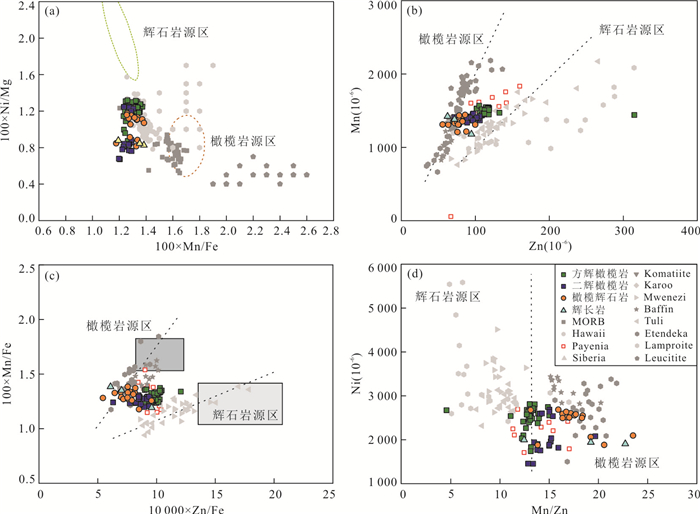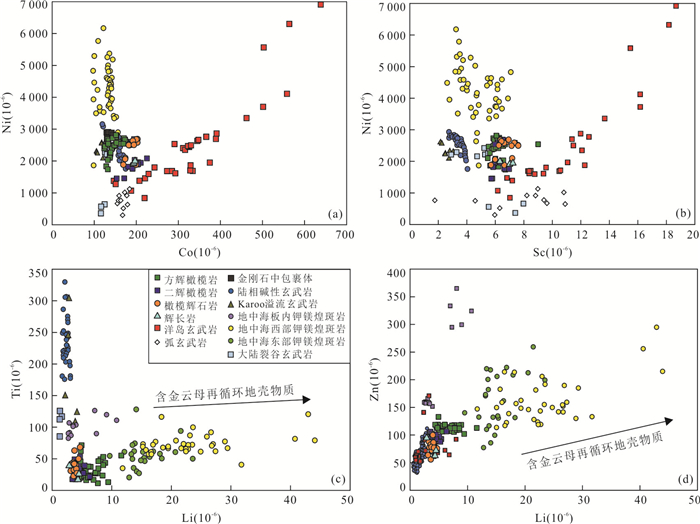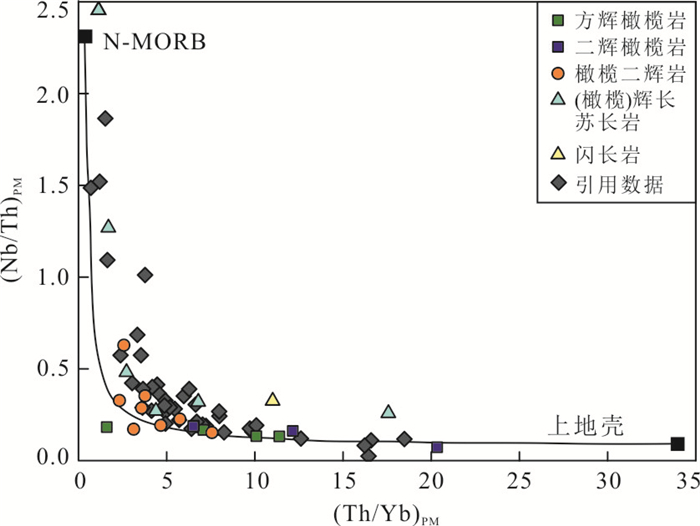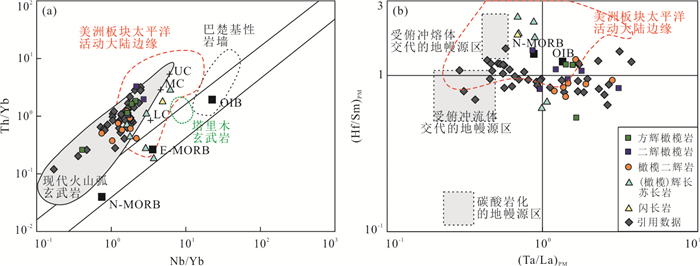Origin of Ore-Forming Magmas Associated with Ni-Cu Sulfide Deposits in Orogenic Belts: Case Study of Permian Huangshannan Magmatic Ni-Cu Sulfide Deposit, East Tianshan, NW China
-
摘要: 位于中亚造山带南缘的新疆东天山地区因其出露大量的二叠纪镁铁质-超镁铁质岩体并产出一系列铜镍硫化物矿床而成为近年来地质学界关注的焦点.选择新疆东天山地区黄山南含铜镍矿镁铁质-超镁铁质岩体为研究对象,对其开展了系统的岩石学、矿物学和地球化学研究,以探讨造山带铜镍硫化物矿床的岩浆起源与性质.黄山南岩体主要由方辉橄榄岩、二辉橄榄岩、橄榄二辉岩、(橄榄)辉长苏长岩和闪长岩组成.各岩相显示富集大离子亲石元素和轻稀土元素、强烈亏损Nb-Ta、Ti,类似于典型岛弧火山岩特征.黄山南镁铁质-超镁铁质岩具有较大变化范围的εNd(t=282.5 Ma)值(-1.31~4.22)和(87Sr/86Sr)i比值(0.703 2~0.706 9)以及高的(206Pb/204Pb)i比值(17.67~18.90),暗示其来源于一个适度富集的亏损地幔并经历了5%~20%新生地壳物质混染和~5%上地壳物质混染.根据橄榄石最高Fo牌号(摩尔含量为86.6%)计算的黄山南母岩浆为苦橄质岩浆(MgO=12.11%、FeOTotal=11.14%、Ni=306×10-6),指示其岩浆源区应为软流圈和交代地幔楔共同熔融的源区.黄山南橄榄石低的Ca(< 725×10-6)和100×Mn/Fe(1.18~1.38)、高的Ni(1 451×10-6~2 813×10-6)和Mn/Zn(11.09~23.53),暗示黄山南母岩浆来源于含有辉石岩的不均一橄榄岩地幔源区.因此,我们推测黄山南岩体的原始岩浆来源于早期经历过俯冲流体改造的含有辉石岩的交代岩石圈地幔源区.Abstract: The East Tianshan is situated along the southern margin of the Central Asian Orogenic Belt, and its outcrops of a series of important magmatic Ni-Cu sulfide deposits hosted by mafic-ultramafic intrusions are the focus of recent studies. In this study, it presents a systematic study of petrology, mineralogy and geochemistry of the Huangshannan sulfide ore-bearing mafic-ultramafic intrusion of the East Tianshan region, in order to further discuss the origin and nature of its parental magma. The Huangshannan intrusion consists of an ultramafic unit, which is composed of harzburgite, lherzolite and olivine websterite, and a mafic unit, which is composed of (olivine) gabbronorite and diorite. The rocks of the intrusion are characterized by enrichments of large ion lithophile elements, light rare earth elements and strong negative Nb-Ta, Ti anomalies, similar to that of typical arc volcanics. These rocks also have variable isotope compositions[εNd(t=282.5 Ma)=(-1.31)-4.22;(87Sr/86Sr)i=0.703 2-0.706 9;(206Pb/204Pb)i=17.67-18.90], indicating the parental magma was derived from a moderately enriched depleted mantle source and contaminated by 5%-20% juvenile arc crust and then by ~5% upper crustal materials. According to its highest Fo olivine, the estimated parental magma of the Huangshannan intrusion has 12.11% MgO, 11.14% FeOTotal and 306×10-6 Ni, indicating the picritic magma was generated from partial melting of both the asthenosphere and mantle wedge. The low Ca (< 725×10-6), 100×Mn/Fe (1.18-1.38) and high Ni (1 451×10-6-2 813×10-6), Mn/Zn (11.09-23.53) ratios of the Huangshannan olivines indicate the Huangshannan parental magma may be derived from pyroxenite in a modally enriched peridotite mantle source. Therefore, it speculates that the Huangshannan primary magmas were likely derived from a lithospheric pyroxenite mantle source as the result of slab-derived fluid modification during previous subduction.
-
图 1 新疆东天山镁铁质-超镁铁质岩体分布
Fig. 1. Simplified geological map of East Tianshan, which shows the distribution of the mafic-ultramafic intrusions and associated sulfide deposits
图 2 东天山东段镁铁质‒超镁铁质岩体、铜镍硫化物矿床分布(a)和黄山南岩体地质平面图以及采样位置(b)
b.据Mao et al.(2016)修改
Fig. 2. Distribution and ages of the mafic-ultramafic intrusions and magmatic sulfide deposits in the eastern section of East Tianshan (a), plan view of the Huangshannan intrusion and the location of sampled drill-core in this study (b)
图 4 黄山南岩体主量元素哈克图解
引用数据来自于Zhao et al.(2015)和Mao et al.(2016). a. SiO2-MgO图解;b. Al2O3-MgO图解;c. TiO2-MgO图解;d.(Na2O+K2O)-MgO图解;e. CaO-MgO图解;f. FeOTotal-MgO图解
Fig. 4. Plots of SiO2 (a), Al2O3 (b), TiO2 (c), (Na2O+ K2O) (d), CaO (e), and FeOTotal (f) vs. MgO in the Huangshannan intrusion
图 5 黄山南岩体稀土元素和微量元素配分图解
球粒陨石和原始地幔来自于Sun and McDonough(1989);黄山南引用数据来自于Zhao et al.(2015)和Mao et al.(2016);黑山来自于Xie et al.(2014);黄山西和黄山东来自于邓宇峰(2011);吐哈玄武岩来自于唐冬梅等(2017);夏日哈木来自于张志炳(2016);金川来自于鲍坚(2019)
Fig. 5. Chondrite-normalized REE patterns and primitive mantle-normalized incompatible element patterns for the Huangshannan intrusion
图 6 黄山南岩体Sr-Nd-Pb同位素相关图
图a演化曲线采用二元混合模型,分别用库鲁克塔格新元古代花岗闪长岩和塔里木元古代片麻状花岗岩为塔里木下、上地壳.香山数据肖庆华(2010);黄山东和黄山西数据邓宇峰(2011);塔里木玄武岩和巴楚基性岩墙数据引自Wei et al.(2014);其他数据引自Xie et al.(2012).黄山南各岩性图例同图 4
Fig. 6. Sr-Nd-Pb isotopes of the Huangshannan intrusion
图 7 黄山南岩体橄榄石Fo-Ni(a);Fo-Ca(b);辉石Wo-En-Fs分类图(c);斜方辉石Mg#-Al2O3(d);单斜辉石TiO2+Cr2O3-Al2O3(e)、TiO2-AlZ(f)和TiO2-Al2O3-Na2O分类图(g)
图a和b中橄榄石数据为电子探针分析结果.香山数据肖庆华(2010);黄山东和黄山西数据邓宇峰(2011);黑山数据引自Xie et al.(2014);夏日哈木橄榄石数据张志炳(2016);金川橄榄石数据康健等(2019);其他数据引自Howarth and Harris(2017)
Fig. 7. Olivine Fo-Ni(a); Fo-Ca(b); pyroxene Wo-En-Fs classfication diagram (c); orthopyroxene Mg#-Al2O3 (d); clinopyroxene TiO2+Cr2O3-Al2O3(e), TiO2-AlZ(f) and TiO2-Al2O3-Na2O(g) classfication diagram
图 8 黄山南岩体橄榄石的100×Mn/Fe-100×Ni/Mg (a);Zn-Mn (b);10 000×Zn/Fe-100×Mn/Fe (c)和Mn/Zn-Ni (d)协变图解
橄榄石数据为LA-ICP-MS分析结果;引用数据来自于Howarth and Harris(2017)
Fig. 8. Huangshannan olivine 100×Mn/Fe-100×Ni/Mg (a); Zn-Mn (b); 10 000×Zn/Fe-100×Mn/Fe (c) and Mn/Zn-Ni (d) covariation diagrams
图 9 黄山南岩体橄榄石的Co-Ni (a);Sc-Ni (b);Li-Ti (c)和Li-Zn (d)协变图解
橄榄石数据为LA-ICP-MS分析结果;引用数据来自于Ammannati et al.(2016)
Fig. 9. Huangshannan olivine Co-Ni (a); Sc-Ni (b); Li-Ti (c) and Li-Zn (d) covariation diagrams
图 10 黄山南岩体(Th/Yb)PM‒(Nb/Th)PM协变图解
Fig. 10. (Th/Yb)PM‒(Nb/Th)PM diagram for the Huangshannan intrusion
图 11 黄山南岩体Nb/Yb-Th/Yb (a)和(Ta/La)PM-(Hf/Sm)PM (b)比值图解
a.底图引自Xie et al.(2012);b.底图引自Zhu et al.(2010)
Fig. 11. Nb/Yb-Th/Yb (a) and (Ta/La)PM-(Hf/Sm)PM (b) diagrams for the Huangshannan intrusion
-
Altunkaynak, Ş., Ünal, A., Howarth, G. H., et al., 2019. The Origin of Low-Ca Olivine from Ultramafic Xenoliths and Host Basaltic Lavas in a Back-Arc Setting, James Ross Island, Antarctic Peninsula. Lithos, 342/343: 276-287. https://doi.org/10.1016/j.lithos.2019.05.039 Ammannati, E., Jacob, D. E., Avanzinelli, R., et al., 2016. Low Ni Olivine in Silica-Undersaturated Ultrapotassic Igneous Rocks as Evidence for Carbonate Metasomatism in the Mantle. Earth and Planetary Science Letters, 444: 64-74. https://doi.org/10.1016/j.epsl.2016.03.039 Bao, J., 2019. Mg-Sr-Nd Isotopic Constraints on the Genesis of the Jinchuan Cu-Ni-(PGE) Sulfide Deposit (Dissertation). Lanzhou University, Lanzhou, 1-61 (in Chinese with English abstract). Barnes, S.J., Lightfoot, P.C., 2005. Formation of Magmatic Nickel Sulfide Ore Deposit and Processes Affecting Their Copper and Platinum Group Element Contents. Economic Geology One Hundredth Anniversary Volume, 179-213. https://doi.org/10.5382/AV100 Cao, Y. H., Wang, C. Y., Wei, B., 2020. Magma Oxygen Fugacity of Mafic-Ultramafic Intrusions in Convergent Margin Settings: Insights for the Role of Magma Oxidation States on Magmatic Ni-Cu Sulfide Mineralization. American Mineralogist, 105(12): 1841-1856. https://doi.org/10.2138/am-2020-7351 Chai, G., Naldrett, A. J., 1992. The Jinchuan Ultramafic Intrusion: Cumulate of a High-Mg Basaltic Magma. Journal of Petrology, 33(2): 277-303. https://doi.org/10.1093/petrology/33.2.277 Chung, S. L., Wang, K. L., Crawford, A. J., et al., 2001. High-Mg Potassic Rocks from Taiwan: Implications for the Genesis of Orogenic Potassic Lavas. Lithos, 59(4): 153-170. https://doi.org/10.1016/S0024-4937(01)00067-6 Deng, Y. F., 2011. Geneses of the Huangshandong and Huangshanxi Mafic-Ultramafic Intrusions and Hosted Cu-Ni Sulfide Deposits, Northern Tianshan, Xinjiang (Dissertation). Institute of Geochemistry, Chinese Academy of Sciences, Guiyang, 1-177 (in Chinese with English abstract). Deng, Y. F., Song, X.Y., Xie, W., et al., 2021. Determination of Sedimentary Ages of Strata in the Huangshan-Jingerquan Mineralization Belt and Its Geological Significance. Acta Geologica Sinica, 95(2): 362-376 (in Chinese with English abstract). DePaolo, D. J., 1981. Trace Element and Isotopic Effects of Combined Wallrock Assimilation and Fractional Crystallization. Earth and Planetary Science Letters, 53(2): 189-202. https://doi.org/10.1016/0012-821X(81)90153-9 Fang, L.R., Tang, D.M., Qin, K.Z., et al., 2019. The Indicative Significance of Amphibole Composition to Magmatic Process of Copper-Nickel Deposits in Eastern Tianshan. Acta Petrologica Sinica, 35(7): 2061-2085 (in Chinese with English abstract) doi: 10.18654/1000-0569/2019.07.08 Foley, S. F., Prelevic, D., Rehfeldt, T., et al., 2013. Minor and Trace Elements in Olivines as Probes into Early Igneous and Mantle Melting Processes. Earth and Planetary Science Letters, 363: 181-191. https://doi.org/10.1016/j.epsl.2012.11.025 Gao, J.F., Lu, J.J., Lai, M.Y., et al., 2003. Analysis of Trace Elements in Rock Samples Using HR-ICPMS. Journal of Nanjing University (Natural Science), 39(6): 844-850 (in Chinese with English abstract). Gao, J. F., Zhou, M. F., 2013. Generation and Evolution of Siliceous High Magnesium Basaltic Magmas in the Formation of the Permian Huangshandong Intrusion (Xinjiang, NW China). Lithos, 162/163: 128-139. https://doi.org/10.1016/j.lithos.2013.01.002 Gaul, O. F., Griffin, W. L., O'Reilly, S. Y., et al., 2000. Mapping Olivine Composition in the Lithospheric Mantle. Earth and Planetary Science Letters, 182(3/4): 223-235. https://doi.org/10.1016/S0012-821X(00)00243-0 Ghiorso, M. S., Sack, R. O., 1995. Chemical Mass Transfer in Magmatic Processes Ⅳ. A Revised and Internally Consistent Thermodynamic Model for the Interpolation and Extrapolation of Liquid-Solid Equilibria in Magmatic Systems at Elevated Temperatures and Pressures. Contributions to Mineralogy and Petrology, 119(2/3): 197-212. https://doi.org/10.1007/BF00307281 Han, B. F., Guo, Z. J., Zhang, Z. C., et al., 2010. Age, Geochemistry, and Tectonic Implications of a Late Paleozoic Stitching Pluton in the North Tian Shan Suture Zone, Western China. Geological Society of America Bulletin, 122(3/4): 627-640. https://doi.org/10.1130/b26491.1 Han, B. F., He, G. Q., Wang, X. C., et al., 2011. Late Carboniferous Collision between the Tarim and Kazakhstan-Yili Terranes in the Western Segment of the South Tian Shan Orogen, Central Asia, and Implications for the Northern Xinjiang, Western China. Earth-Science Reviews, 109(3-4): 74-93. https://doi.org/10.1016/j.earscirev.2011.09.001 Han, C. M., Xiao, W. J., Zhao, G. C., et al., 2007. Re-Os Dating of the Kalatongke Cu-Ni Deposit, Altay Shan, NW China, and Resulting Geodynamic Implications. Ore Geology Reviews, 32(1/2): 452-468. https://doi.org/10.1016/j.oregeorev.2006.11.004 Hart, S. R., 1984. A Large-Scale Isotope Anomaly in the Southern Hemisphere Mantle. Nature, 309(5971): 753-757. https://doi.org/10.1038/309753a0 Herzberg, C., Asimow, P. D., 2008. Petrology of Some Oceanic Island Basalts: PRIMELT2. XLS Software for Primary Magma Calculation. Geochemistry, Geophysics, Geosystems, 9(9): Q09001. https://doi.org/10.1029/2008gc002057 Hofmann, A. W., Jochum, K. P., 1996. Source Characteristics Derived from Very Incompatible Trace Elements in Mauna Loa and Mauna Kea Basalts, Hawaii Scientific Drilling Project. Journal of Geophysical Research: Solid Earth, 101(B5): 11831-11839. https://doi.org/10.1029/95JB03701 Howarth, G. H., Harris, C., 2017. Discriminating between Pyroxenite and Peridotite Sources for Continental Flood Basalts (CFB) in Southern Africa Using Olivine Chemistry. Earth and Planetary Science Letters, 475: 143-151. https://doi.org/10.1016/j.epsl.2017.07.043 Hu, A.Q., Zhang, G.X., Chen, Y.B., 2006. Isotope Geochronology and Geochemistry for Major Geological Events of Continental Crustal Evolution of Xinjiang, China. Geological Publishing House, Beijing, 427. Johnson, M.C., Plank, T., 1999. Dehydration and Melting Experiments Constrain the Fate of Subducted Sediments. Geochemistry, Geophysics, Geosystems, (1): 1007. https://doi.org/10.1029/1999GC000014 Kang, J., Chen, L.M., Song, X.Y., et al., 2019. Trace Elements in Olivines from the Giant Jinchuan Ni-Cu-(PGE) Deposit, NW China, and Its Geological Implication. Advances in Earth Science, 34(4): 382-398 (in Chinese with English abstract). http://en.cnki.com.cn/Article_en/CJFDTotal-DXJZ201904008.htm Khain, E.V., Bibikova, E.V., Salnikova, E.B., et al., 2003. The Palaeo-Asian Ocean in the Neoproterozoic and Early Palaeozoic: New Geochronologic Data and Palaeotectonic Reconstructions. Precambrian Research, 122: 329-358. https://doi.org/10.1016/S0301-9268(02)00218-8 Le Bas, M.J., 2000. IUGS Reclassification of the High-Mg and Picritic Volcanic Rocks. Journal of Petrology, 41: 1467-1470. https://doi.org/10.1093/petrology/41.10.1467 Lesher, C.M., Keays, R.R., 2002. Komatiite-Associated Ni-Cu-(PGE) Deposits: Mineralogy, Geochemistry, and Genesis. In: Cabri, L.J., ed., The Geology, Geochemistry, Mineralogy, and Mineral Beneficiation of the Platinum-Group Elements. Canadian Institute of Mining, Metallurgy, and Petroleum, 54: 579-617. Li, C.S., Ripley, E.M., 2011. The Jinchuan Ni-Cu-(PGE) Deposit: Tectonic Setting, Magma Evolution, Ore Genesis, and Exploration Implications. In: Li, C.S., Ripley, E.M., eds., Magmatic Ni-Cu and PGE Deposits: Geology, Geochemistry, and Genesis. Society of Economic Geology Special Publication, 17: 164-180. https://doi.org/10.5382/Rev.17 Li, C. S., Xu, Z. H., Waal, S. A., et al., 2004. Compositional Variations of Olivine from the Jinchuan Ni-Cu Sulfide Deposit, Western China: Implications for Ore Genesis. Mineralium Deposita, 39(2): 159-172. https://doi.org/10.1007/s00126-003-0389-5 Li, N., 2020. Metallogenesis of the Xiaobaishitou W-(Mo) Deposit in East Tianshan, Xinjiang (Dissertation). Chinese Academy of Geological Sciences, Beijing, 1-195 (in Chinese with English abstract). Libourel, G., 1999. Systematics of Calcium Partitioning between Olivine and Silicate Melt: Implications for Melt Structure and Calcium Content of Magmatic Olivines. Contributions to Mineralogy and Petrology, 136: 63-80. https://doi.org/10.1007/s004100050524 Lu, Y. G., Lesher, C. M., Deng, J., 2019. Geochemistry and Genesis of Magmatic Ni-Cu-(PGE) and PGE-(Cu)-(Ni) Deposits in China. Ore Geology Reviews, 107: 863-887. https://doi.org/10.1016/j.oregeorev.2019.03.024 Maier, W. D., Barnes, S. J., Sarkar, A., et al., 2010. The Kabanga Ni Sulfide Deposit, Tanzania: I. Geology, Petrography, Silicate Rock Geochemistry, and Sulfur and Oxygen Isotopes. Mineralium Deposita, 45(5): 419-441. https://doi.org/10.1007/s00126-010-0280-0 Mao, Y.J., Qin, K.Z., Barnes, S.J., et al., 2017. Genesis of the Huangshannan High-Ni Tenor Magmatic Sulfide Deposit in the Eastern Tianshan, Northwest China: Constraints from PGE Geochemistry and Os-S Isotopes. Ore Geology Reviews, 90: 591-606. https://doi.org/10.1016/j.oregeorev.2017.05.015 Mao, Y.J., Qin, K.Z., Li, C., et al., 2014. Petrogenesis and Ore Genesis of the Permian Huangshanxi Sulfide Ore-Bearing Mafic-Ultramafic Intrusion in the Central Asian Orogenic Belt, Western China. Lithos, 200: 111-125. https://doi.org/10.1016/j.lithos.2014.04.008 Mao, Y.J., Qin, K.Z., Tang, D.M., 2018. Characteristics, Genetic Mechanism, and Exploration Perspective of Ni-Rich Sulfide in Magmatic Ni-Cu Systems. Acta Petrologica Sinica, 34(8): 2410-2424 (in Chinese with English abstract). Mao, Y. J., Qin, K. Z., Tang, D. M., et al., 2016. Crustal Contamination and Sulfide Immiscibility History of the Permian Huangshannan Magmatic Ni-Cu Sulfide Deposit, East Tianshan, NW China. Journal of Asian Earth Sciences, 129: 22-37. https://doi.org/10.1016/j.jseaes.2016.07.028 Mavrogenes, J. A., O'Neill, H. S. C., 1999. The Relative Effects of Pressure, Temperature and Oxygen Fugacity on the Solubility of Sulfide in Mafic Magmas. Geochimica et Cosmochimica Acta, 63(7/8): 1173-1180. https://doi.org/10.1016/S0016-7037(98)00289-0 Naldrett, A.J., 2004. Magmatic Sulfide Deposits: Geology, Geochemistry and Exploration. Springer-Verlag, Berlin, 1-728. https://doi.org/10.1007/978-3-662-08444-1 Naldrett, A.J., 2011. Fundamentals of Magmatic Sulfide Deposits. In: Li, C.S., Ripley E.M., eds., Magmatic Ni-Cu and PGE Deposits: Geology, Geochemistry, and Genesis. Society of Economic Geology Special Publication, 17: 1-26. https://doi.org/10.5382/Rev.17 Paton, C., Hellstrom, J., Paul, B., et al., 2011. Iolite: Freeware for the Visualisation and Processing of Mass Spectrometric Data. Journal of Analytical Atomic Spectrometry, 26(12): 2508-2518. https://doi.org/10.1039/c1ja10172b Pearce, J. A., Peate, D. W., 1995. Tectonic Implications of the Composition of Volcanic ARC Magmas. Annual Review of Earth and Planetary Sciences, 23(1): 251-285. https://doi.org/10.1146/annurev.ea.23.050195.001343 Pearce, J.A., Thirlwall, M.F., Ingram, G., et al., 1992. Isotopic Evidence for the Origin of Boninites and Related Rocks Drilled in the Izu-Bonin (Ogasawara) Forearc, Leg 125. Proceedings of the Ocean Drilling Program Scientific Results, 125: 237-261. https://doi.org/10.2973/odp.proc.sr.125.134.1992 Piña, R., Lunar, R., Ortega, L., et al., 2006. Petrology and Geochemistry of Mafic-Ultramafic Fragments from the Aguablanca Ni-Cu Ore Breccia, Southwest Spain. Economic Geology, 101: 865-881. https://doi.org/10.2113/gsecongeo.101.4.865 Roeder, P.L., Emslie, R.F., 1970. Olivine-Liquid Equilibrium. Contributions to Mineralogy and Petrology, 29: 275-289. https://doi.org/10.1007/BF00371276 Rollinson, H.R., 1993. Using Geochemical Data: Evaluation, Presentation, Interpretation. Longman, London, 1-352. Ruan, B.X., Lü, X.B., Yu, Y.M., et al., 2020. Petrogenesis, Mineralization and Prospecting Information of Permian Mafic-Ultramafic Rocks, Beishan, Xinjiang. Earth Science, 45(12): 4481-4497 (in Chinese with English abstract). Ruan, B. X., Yu, Y. M., Lü, X., et al., 2020. Sulfide Segregation Mechanism of Magmatic Ni Mineralization in Western Beishan Region, Xinjiang, NW China: Case Study of the Hongshishan Mafic-Ultramafic Complex. Ore Geology Reviews, 122: 103503. https://doi.org/10.1016/j.oregeorev.2020.103503 Şengör, A. M. C., Natal'in, B. A., Burtman, V. S., 1993. Evolution of the Altaid Tectonic Collage and Palaeozoic Crustal Growth in Eurasia. Nature, 364(6435): 299-307. https://doi.org/10.1038/364299a0 Sobolev, A.V., Hofmann, A.W., Kuzmin, D.V., et al., 2007. The Amount of Recycled Crust in Sources of Mantle-Derived Melts. Science, 316: 412-417. https://doi.org/10.1126/science.1138113 Sobolev, A.V., Hofmann, A.W., Sobolev, S.V., et al., 2005. An Olivine-Free Mantle Source of Hawaiian Shield Basalts. Nature, 434: 590-597. https://doi.org/10.1038/nature03411 Song, X.Y., Li, X.R., 2009. Geochemistry of the Kalatongke Ni-Cu-(PGE) Sulfide Deposit, NW China: Implications for the Formation of Magmatic Sulfide Mineralization in a Postcollisional Environment. Mineralium Deposita, 44: 303-327. https://doi.org/10.1007/s00126-008-0219-x Song, X.Y., Xie, W., Deng, Y.F., et al., 2011. Slab Break-off and the Formation of Permian Mafic-Ultramafic Intrusions in Southern Margin of Central Asian Orogenic Belt, Xinjiang, NW China. Lithos, 127: 128-143. https://doi.org/10.1016/j.lithos.2011.08.011 Song, X. Y., Yi, J. N., Chen, L. M., et al., 2016. The Giant Xiarihamu Ni-Co Sulfide Deposit in the East Kunlun Orogenic Belt, Northern Tibet Plateau, China. Economic Geology, 111(1): 29-55. https://doi.org/10.2113/econgeo.111.1.29 Su, B.X., Qin, K.Z., Tang, D.M., et al., 2013. Late Paleozoic Mafic-Ultramafic Intrusions in Southern Central Asian Orogenic Belt (NW China): Insight into Magmatic Ni-Cu Sulide Mineralization in Orogenic Setting. Ore Geology Reviews, 51: 57-73. https://doi.org/10.1016/j.oregeorev.2012.11.007 Sun, S. S., McDonough, W. F., 1989. Chemical and Isotopic Systematics of Oceanic Basalts: Implications for Mantle Composition and Processes. Geological Society, London, Special Publications, 42(1): 313-345. https://doi.org/10.1144/gsl.sp.1989.042.01.19 Tang, D.M., Qin, K.Z., Xue, S.C., et al., 2017. Nature of Primitive Magmas of Early Permian Basalts in Tuha Basin, Xinjiang: Constraints from Melt Inclusions. Acta Petrologica Sinica, 33(2): 339-353 (in Chinese with English abstract). Wang, C. Y., Zhou, M. F., Qi, L., 2007. Permian Flood Basalts and Mafic Intrusions in the Jinping (SW China)-Song Da (Northern Vietnam) District: Mantle Sources, Crustal Contamination and Sulfide Segregation. Chemical Geology, 243(3/4): 317-343. https://doi.org/10.1016/j.chemgeo.2007.05.017 Wang, X.C., Li, X.H., Li, W.X., et al., 2008. The Bikou Basalts in the Northwestern Yangtze Block, South China: Remnants of 820-810 Ma Continental Flood Basalts?. Geological Society of America Bulletin, 120: 1478-1492. https://doi.org/10.1130/B26310.1 Wei, X., Xu, Y. G., Feng, Y. X., et al., 2014. Plume-Lithosphere Interaction in the Generation of the Tarim Large Igneous Province, NW China: Geochronological and Geochemical Constraints. American Journal of Science, 314(1): 314-356. https://doi.org/10.2475/01.2014.09 Windley, B.F., Alexeiev, D., Xiao, W.J., et al., 2007. Tectonic Models for Accretion of the Central Asian Orogenic Belt. Journal of Geological Society, 164: 31-47. https://doi.org/10.1144/0016-76492006-022 Woodhead, J., Hellstrom, J., Hergt, J., et al., 2007. Isotopic and Elemental Imaging of Geological Materials by Laser Ablation Inductively Coupled Plasma Mass Spectrometry. Journal of Geostandards and Geoanalytical Research, 31: 331-343. https://doi.org/10.1111/j.1751-908X.2007.00104.x Xiao, Q.H., 2010. Origin of Xiangshanxi Cu-Ni-Ti-Fe Composite Deposit in Eastern Tianshan, NW China, and Its Implications (Dissertation). Institute of Geology and Geophysics, Chinese Academy of Sciences, Beijing, 1-191 (in Chinese with English abstract). Xiao, W.J., Windley, B.F., Allen, M.B., et al., 2013. Paleozoic Multiple Accretionary and Collisional Tectonics of the Chinese Tianshan Orogenic Collage. Gondwana Research, 23: 1316-1341. https://doi.org/10.1016/j.gr.2012.01.012 Xiao, W.J., Zhang, L.C., Qin, K.Z., et al., 2004. Paleozoic Accretionary and Collisional Tectonics of the Eastern Tianshan (China): Implications for the Continental Growth of Central Asia. American Journal of Science, 304: 370-395. https://doi.org/10.2475/ajs.304.4.370 Xie, W., Song, X. Y., Chen, L. M., et al., 2014. Geochemistry Insights on the Genesis of the Subduction-Related Heishan Magmatic Ni-Cu-(PGE) Deposit, Gansu, Northwestern China, at the Southern Margin of the Central Asian Orogenic Belt. Economic Geology, 109(6): 1563-1583. https://doi.org/10.2113/econgeo.109.6.1563 Xie, W., Song, X. Y., Deng, Y. F., et al., 2012. Geochemistry and Petrogenetic Implications of a Late Devonian Mafic-Ultramafic Intrusion at the Southern Margin of the Central Asian Orogenic Belt. Lithos, 144/145: 209-230. https://doi.org/10.1016/j.lithos.2012.03.010 Xu, X.Y., Li, X.M., Ma, Z.P., et al., 2006a. LA-ICPMS Zircon U-Pb Dating of Gabbro from the Bayingou Ophiolite in the Northern Tianshan Mountains. Acta Geologica Sinica, 80(8): 1168-1176 (in Chinese with English abstract). http://epub.cnki.net/grid2008/docdown/docdownload.aspx?filename=DZXE200608020&dbcode=CJFD&year=2006&dflag=pdfdown Xu, X.Y., Xia, L.Q., Ma, Z.P., et al., 2006b. SHRIMP Zircon U-Pb Geochronology of the Plagiogranites from Bayingou Ophiolite in North Tianshan Mountains and the Petrogenesis of the Ophiolite. Acta Petrologica Sinica, 22(1): 83-94 (in Chinese with English abstract). Yang, J.S., Xu, X.Z., Li, T.F., et al., 2011. U-Pb Ages of Zircons from Ophiolite and Related Rocks in the Kumishi Region at the Southern Margin of Middle Tianshan, Xinjiang: Evidence of Early Paleozoic Oceanic Basin. Acta Petrologica Sinica, 27(1): 77-95 (in Chinese with English abstract). Yang, S. H., Maier, W. D., Hanski, E. J., et al., 2013. Origin of Ultra-Nickeliferous Olivine in the Kevitsa Ni-Cu-PGE-Mineralized Intrusion, Northern Finland. Contributions to Mineralogy and Petrology, 166(1): 81-95. https://doi.org/10.1007/s00410-013-0866-5 Yao, Z., Mungall, J. E., Jenkins, M. C., 2021. The Rustenburg Layered Suite Formed as a Stack of Mush with Transient Magma Chambers. Nat. Commun., 12(1): 505. https://doi.org/10.1038/s41467-020-20778-w Zhang, Y., Wei, X., Xu, Y. G., et al., 2017. Sr-Nd-Pb Isotopic Compositions of the Lower Crust beneath Northern Tarim: Insights from Igneous Rocks in the Kuluketage Area, NW China. Mineralogy and Petrology, 111(2): 237-252. https://doi.org/10.1007/s00710-016-0470-2 Zhang, Z.B., 2016. Genetic Significance from Mineralogy of Xiarihamu Ni-Cu Sulfide Deposit, Eastern Kunlun Orogenic Belt (Dissertation). China University of Geosciences, Beijing (in Chinese with English abstract). Zhao, Y., 2016. Magmatic Sulfide Mineralization of the Cluster of Ni-Cu Deposits in the Eastern Tianshan and the Application of Cu Isotopes for Tracing Concealed Orebodies (Dissertation). China University of Geosciences, Beijing, 1-139 (in Chinese with English abstract). Zhao, Y., Xue, C. J., Zhao, X. B., et al., 2015. Magmatic Cu-Ni Sulfide Mineralization of the Huangshannan Mafic-Untramafic Intrusion, Eastern Tianshan, China. Journal of Asian Earth Sciences, 105: 155-172. https://doi.org/10.1016/j.jseaes.2015.03.031 Zhao, Y., Xue, C. J., Zhao, X. B., et al., 2016. Origin of Anomalously Ni-Rich Parental Magmas and Genesis of the Huangshannan Ni-Cu Sulfide Deposit, Central Asian Orogenic Belt, Northwestern China. Ore Geology Reviews, 77: 57-71. https://doi.org/10.1016/j.oregeorev.2016.02.003 Zhu, W. G., Zhong, H., Li, X. H., et al., 2010. The Early Jurassic Mafic-Ultramafic Intrusion and A-Type Granite from Northeastern Guangdong, SE China: Age, Origin, and Tectonic Significance. Lithos, 119(3/4): 313-329. https://doi.org/10.1016/j.lithos.2010.07.005 鲍坚, 2019. Mg-Sr-Nd同位素组成对金川Cu-Ni-(PGE)硫化物矿床成因的制约(硕士学位论文). 兰州: 兰州大学, 1-61. 邓宇峰, 2011. 新疆北天山黄山东与黄山西镁铁-超镁铁岩体及Cu-Ni硫化物矿床成因(博士学位论文). 贵阳: 中国科学院地球化学研究所, 1-177. 邓宇峰, 宋谢炎, 颉炜, 等, 2021. 黄山-镜儿泉铜镍成矿带地层时代的厘定及其地质意义探讨. 地质学报, 95(2): 362-376. https://www.cnki.com.cn/Article/CJFDTOTAL-DZXE202102006.htm 方林茹, 唐冬梅, 秦克章, 等, 2019. 角闪石成分对东天山铜镍矿床岩浆过程的指示意义. 岩石学报, 35(7): 2061-2085. https://www.cnki.com.cn/Article/CJFDTOTAL-YSXB201907008.htm 高剑峰, 陆建军, 赖鸣远, 等, 2003. 岩石样品中微量元素的高分辨率等离子质谱分析. 南京大学学报(自然科学版), 39(6): 844-850. doi: 10.3321/j.issn:0469-5097.2003.06.014 康健, 陈列锰, 宋谢炎, 等, 2019. 金川超大型Ni-Cu-(PGE)矿床橄榄石微量元素特征及地质意义. 地球科学进展, 34(4): 382-398. https://www.cnki.com.cn/Article/CJFDTOTAL-DXJZ201904008.htm 李宁, 2020. 新疆东天山小白石头钨(钼)矿床成矿作用研究(博士学位论文). 北京: 中国地质科学院, 1-195. 毛亚晶, 秦克章, 唐冬梅, 2018. 高镍铜镍矿床的特征、形成机制与勘查展望. 岩石学报, 34(8): 2410-2424. https://www.cnki.com.cn/Article/CJFDTOTAL-YSXB201808014.htm 阮班晓, 吕新彪, 俞颖敏, 等, 2020. 新疆北山二叠纪镁铁-超镁铁质岩成因、成矿作用和找矿信息. 地球科学, 45(12): 4481-4497. doi: 10.3799/dqkx.2020.245 唐冬梅, 秦克章, 薛胜超, 等, 2017. 吐哈盆地早二叠世玄武岩原始岩浆性质: 来自熔融包裹体成分的制约. 岩石学报, 33(2): 339-353. https://www.cnki.com.cn/Article/CJFDTOTAL-YSXB201702003.htm 肖庆华, 2010. 新疆东天山香山西铜镍-钛铁复合型矿床成因研究及意义(博士学位论文). 北京: 中国科学院地质与地球物理研究所, 1-191. 徐学义, 李向民, 马中平, 等, 2006a. 北天山巴音沟蛇绿岩形成于早石炭世: 来自辉长岩LA-ICPMS锆石U-Pb年龄的证据. 地质学报, 80(8): 1168-1176. https://www.cnki.com.cn/Article/CJFDTOTAL-DZXE200608020.htm 徐学义, 夏林圻, 马中平, 等, 2006b. 北天山巴音沟蛇绿岩斜长花岗岩SHRIMP锆石U-Pb年龄及蛇绿岩成因研究. 岩石学报, 22(1): 83-94. https://www.cnki.com.cn/Article/CJFDTOTAL-YSXB200601009.htm 杨经绥, 徐向珍, 李天福, 等, 2011. 新疆中天山南缘库米什地区蛇绿岩的锆石U-Pb同位素定年: 早古生代洋盆的证据. 岩石学报, 27(1): 77-95. https://www.cnki.com.cn/Article/CJFDTOTAL-YSXB201101006.htm 张志炳, 2016. 东昆仑夏日哈木铜镍硫化物矿床矿物成因意义探讨(硕士学位论文). 北京: 中国地质大学. 赵云, 2016. 东天山岩浆Cu-Ni矿集区成矿作用及Cu同位素示踪研究(博士学位论文). 北京: 中国地质大学, 1-139. -
 dqkxzx-46-11-3829-附表.pdf
dqkxzx-46-11-3829-附表.pdf

-









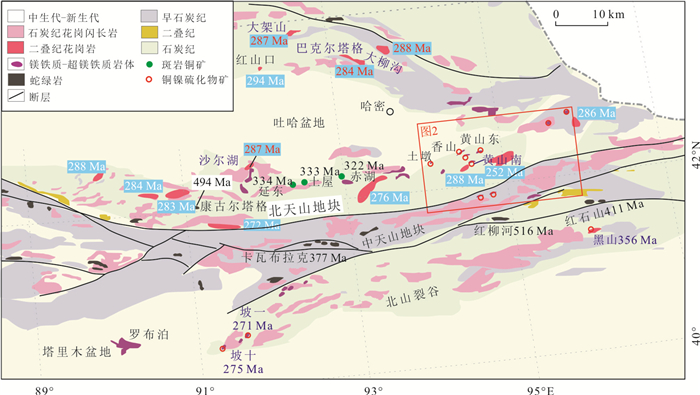
 下载:
下载:

